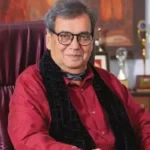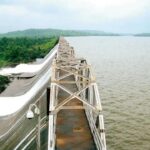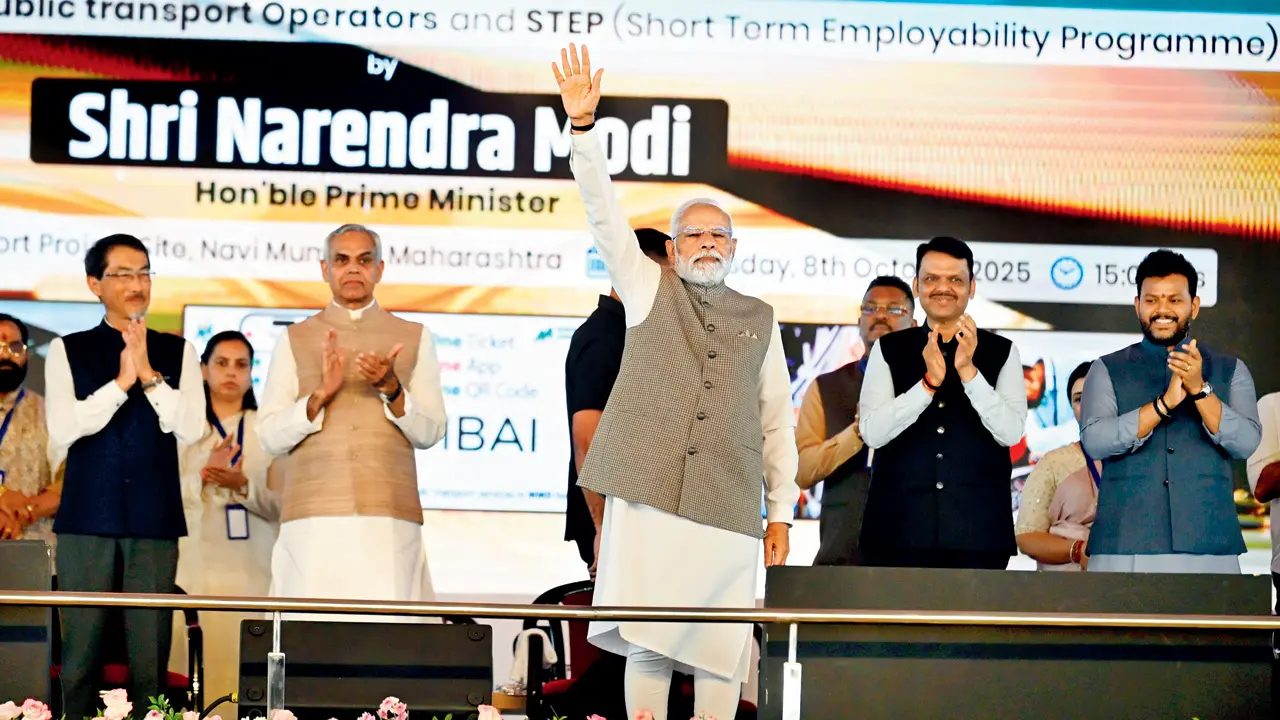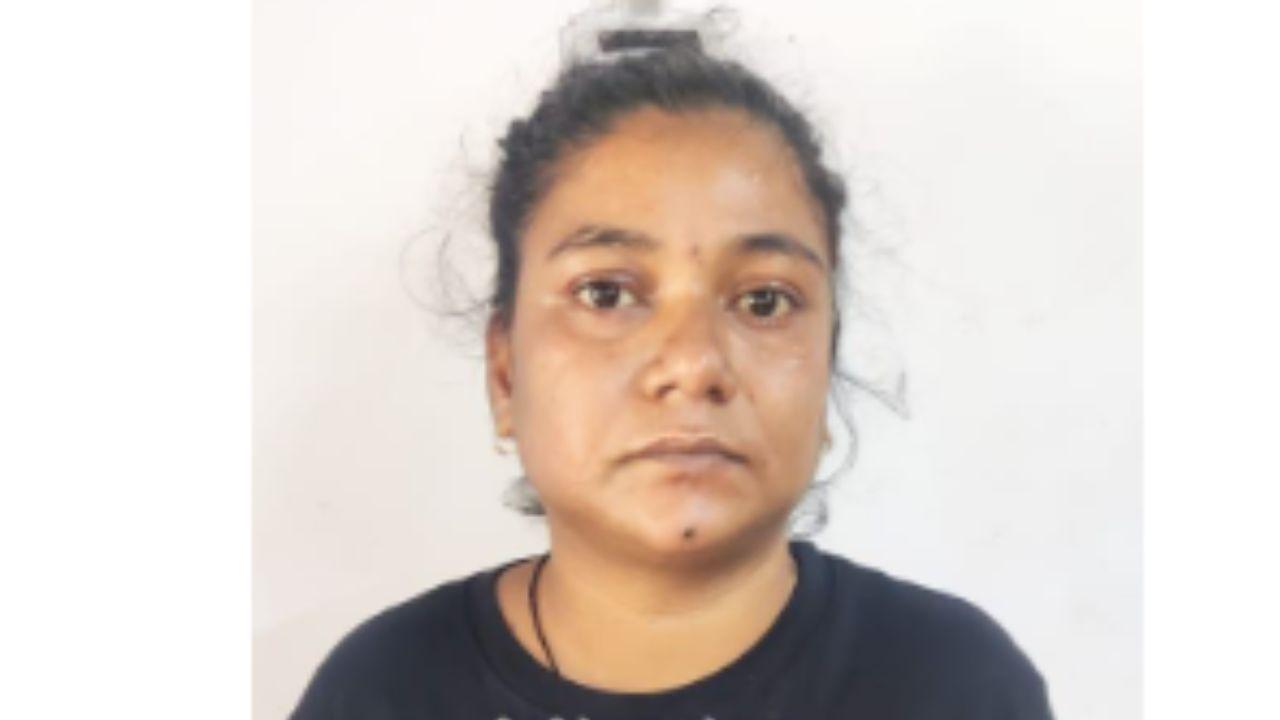The long-awaited Navi Mumbai International Airport (NMIA) was finally inaugurated on Wednesday by Prime Minister Narendra Modi. The ceremony took place after the Prime Minister landed at the new airport around 2.40 pm. Following this, he inaugurated the final phase of the Mumbai Metro Line 3, the Mumbai One app, and the Support to Training and Employment Programme for Women (STEP) programme.
Prime Minister Narendra Modi is presented a memento by Chief Minister Devendra Fadnavis and his deputies Ajit Pawar (left) and Eknath Shinde (right) during the inauguration of Phase 1 of the Navi Mumbai International Airport, in Ulwe on Wednesday. PICS/ATUL KAMBLE
“With this airport, India’s aviation network will grow to further heights; it will provide even the layman a chance to travel via air,” said Modi. “The Navi Mumbai International Airport is a project that exemplifies the vision of a developed India,” he added. Minister of Civil Aviation Kinjarapu Ram Mohan Naidu, in his speech during the inauguration, said, “The new airport’s ecosystem will provide more than two lakh jobs for the youth of the country.”
Operation information
The first phase of NMIA, the country’s largest greenfield airport, constructed on an area spanning 1160 hectares, has been built at a cost of Rs 19,650 crore. Multiple airlines are expected to release ticket fare details later this month, as the airport is expected to open in late December. According to sources, the Central Industrial Security Force (CISF) will conduct a thorough security search of the airport, which might take at least 30 days, while other processes involving immigration and customs take place, only after which domestic and international operations will commence.
Citizens throng the site of the inauguration to catch a glimpse of the Prime Minister
IndiGo, Akasa Air, and Air India, three of India’s most prominent domestic airlines, have already announced their operations from the airport. IndiGo, in May, was the first airline to announce operations from NMIA, stating that it would be expanding from 18 flights on the first day to 140 flights eventually. The first 18 daily flights would be to more than 15 Indian cities.
A month later, Akasa Air stated that it would operate 100-plus weekly domestic departures initially, scaling up to 300-plus domestic and over 50-plus international departures weekly in the winter schedule. Air India announced in September that its subsidiary, Air India Express, would operate 20 daily departures or 40 Air Traffic Movements (ATMs) from and to NMIA, connecting 15 Indian cities, and that it eventually intended to scale up to 55 daily departures (110 ATMs) by mid-2026, including up to five daily international flights from NMIA.
By winter 2026, Air India aims to further expand its operations to 60 daily departures (120 ATMs) from NMIA, seamlessly connecting passengers to key domestic and international destinations. Campbell Wilson, chief executive officer and managing director of Air India, told mid-day, “We are starting with 20 operations from NMIA, and intend to introduce new schedules and destinations from the new airport. We intend to provide more options from NMIA while not taking away the connectivity from CSMIA.”
Cops at NMIA brave blazing sun
Even as the Navi Mumbai International Airport (NMIA) shimmered in splendour amid its inauguration on Wednesday, there was another sight that caught attention — one that spoke of quiet duty and endurance. Under the blazing afternoon sun, traffic police and security personnel stood tirelessly along airport routes, ensuring that the city’s most anticipated event went off without a hitch.
Police personnel attempt to beat the heat near the Navi Mumbai International Airport on Wednesday. Pics/Amarjeet Singh
From 10.30 am, several stretches around Ulwe and areas surrounding the NMIA witnessed heavy deployment of police personnel. Few were seen patrolling with umbrellas, while others sought a momentary respite under the shade of small trees. The heat was unrelenting, with temperatures soaring, yet the traffic moved smoothly, a testament to their discipline and coordination.
A constable stationed near the NMIA entrance shared on condition of anonymity, “We got lunch and water, but tea was not served. The sun was unbearable, but we had to stay alert. With the Prime Minister’s visit and VIP movement, we couldn’t afford to make even a small mistake.” Another officer, resting briefly near a barricade, added with a faint smile, “The only shade we found was from our umbrellas and the trees. It’s part of our duty. We just wanted everything to go peacefully, and it did.”
For many officers, the task was clear: maintain law and order, regulate vehicles, and ensure that no untoward incident disrupted the historic inauguration. Despite the scorching heat, no one left their post. Some officers even guided pedestrians and managed crowds patiently, while others coordinated traffic diversions seamlessly.
– Amarjeet Singh











